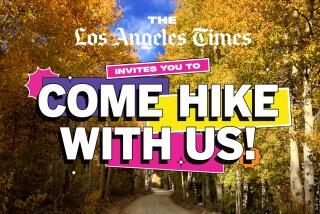a wanderer’s guide to wonderful WILDFLOWERS
“Spectacular!” is the forecast for this spring’s wildflower show in the Santa Monica Mountains. It will be most spectacular and most surprising where the hills have been scorched by wildfires, but delightful displays also awaits the adventuresome wherever the brush is not too dense--in little clearings and canyon bottoms or along road cuts. On Mulholland Drive, drop into second gear and you’ll see lupins and paintbrush clinging to eroding road cuts. Dare to slow down on Pacific Coast Highway and you’ll find poppies and coreopsis. But park your car and the flowery riches of the Santa Monica Mountains will be worthy of comparison to the splendors of the better-known high-desert wildflower show.
You’ll find flowers that would seem more at home in an Alpine meadow. Along Mugu Peak Trail, atop the bluff overlooking the sandy campgrounds at Point Mugu State Park, are clumps of shooting star--not the same shooting star that blazes across Tuolumne Meadows after the snow melts but a close, robust relative that grows even larger. On top of Decker Ridge, at the northwestern extreme of this urban mountain range, are scattered plants of Lewisia rediva , named after the Lewis of Lewis and Clark, who first found them in the Rocky Mountains. This member of the portulaca family is a favorite in English rock gardens and the state flower of Montana, and, before 1981, was thought to grow only in the northern half of California.
True, it is not always so easy to find anything scarcer than a California poppy or a ceanothus. The more unusual plants tend to survive where their existence is not so obvious. Many of the most spectacular appear after a brush fire. Their long-suffering seed needs the heat to germinate and the sudden sun (after the dense brush is gone) to sprout and grow. But if you promise not to pick any of these pretty flowers, we’ll tell you about a few places to look. Remember, their ability to exist so close to a major city is remarkable but can easily be undone.
There were few fires this year, thanks to the abnormal rainfall in late summer and early fall, but there was a controversial “prescribed burn” in Topanga State Park, along the Musch Ranch trail. The trail head is north of the Trippet Ranch parking lot off Topanga Canyon Boulevard. This situation should make for an interesting observation, since the fire, started on purpose, presumably did not burn as hot as most; which wildflowers will follow in its path are anybody’s guess. Nearby was an unplanned fire, adjacent to Topanga Canyon Boulevard, about two miles south (on the coast side) of the summit. Goldfields and deep-purple phacelias are two annual wildflowers that make the desert so spectacular, but they also grow in grand colonies after a fire in the Santa Monica Mountains. Also, expect to see perennial plants such as the scarlet larkspur (one of the parents of today’s garden delphiniums) or Humboldt lilies in a fire-damaged area. These perennial or bulbous plants are not prompted to sprout by the flames; they were always there. The fire has uncovered them, however, and they suddenly stand out in blazing contrast to the burnt slopes. Humboldt lilies, an exciting find even in Northern California, are often found in the more moist canyon bottoms in the Santa Monica Mountains, including the easily accessable upper Temescal Canyon trail in Pacific Palisades.
The Overlook Trail in Malibu Creek State Park burned three years ago but is still likely to have spectacular displays of flowers, some vof them very rare and seldom seen.
Despite small number of fires, the ample and evenly spaced rainfall of this past winter should guarantee good displays of wildflowers, especially shrubs and perennial plants. Brilliant, scarlet penstemon will bloom in just about any hot, south-facing location. At the other extreme, in the moist and shady canyons, you’ll find our own native rose, Rosa californica . Monkey flowers, ceanothus, bush poppy and wooly blue curls are reliable bloomers throughout the chaparral, and even rocky ledges will have succulents, such as the several kinds of dudleyas, in bloom.
Several groups schedule walks during this season of floral bloom, and that is one sure way to find the more-reclusive sorts. The California Native Plant Society leads walks in the Santa Monica Mountains on alternate Saturdays--March 2, 16 and 30 and April 13 and 27. There are two designated meeting places: in West Los Angeles, at the Federal Building parking lot on Wilshire Boulevard, just east of the San Diego Freeway, at 8:45 a.m.; in the San Ferndando Valley, in the parking lot of Taft High School on Ventura Boulevard in Woodland Hills, at 9 a.m. Both groups eventually meet for the hike, and car-pooling from the meeting place is voluntary. Bring water and a lunch and wear shoes that can handle rough trails. Expect to return sometime between 1 and 3 p.m.
The Sierra Club leads walks every Tuesday, beginning at 9 a.m. Telephone (818) 344-8714 for meeting places and other details.
The rangers and docents of the Santa Monica Mountains National Recreation Area also lead talks throughout the season. For information, telephone (818) 888-3440, or visit their headquarters at 22900 Ventura Blvd., Woodland Hills. Hours are 8 a.m. to 5 p.m., Monday through Friday; you’ll be told where you can obtain a brochure that lists the various hikes and other events planned. There are more than 30 walks this month in this huge recreation area, including “Babes in the Woods” walks for folks with children in strollers, “Nature Jogs” for those who are used to viewing the surroundings at speed, and “Sunday Strolls” for those who like a somewhat easier pace.
More to Read
Sign up for The Wild
We’ll help you find the best places to hike, bike and run, as well as the perfect silent spots for meditation and yoga.
You may occasionally receive promotional content from the Los Angeles Times.






